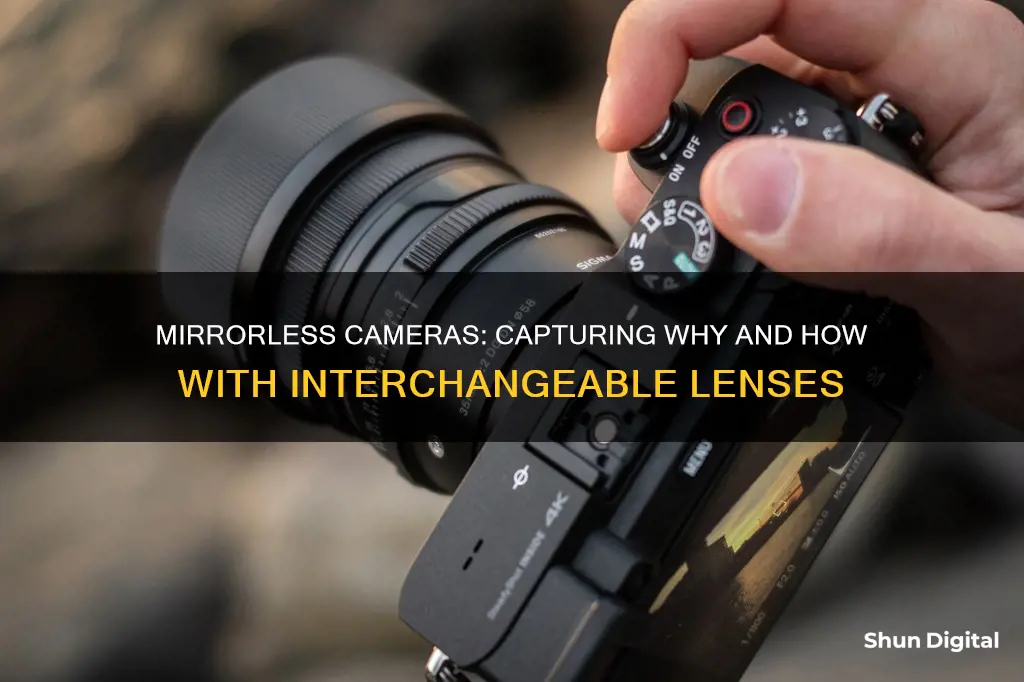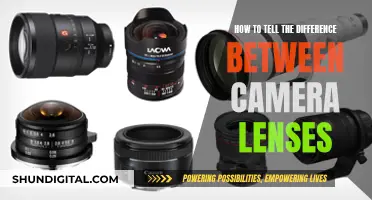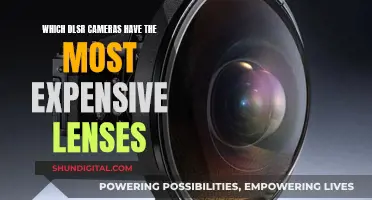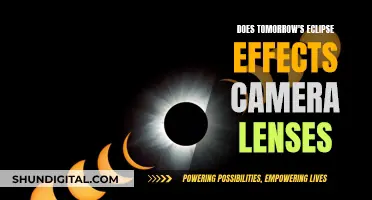
Mirrorless cameras are a new class of digital cameras that improve upon the DSLR camera design. They are called mirrorless because they do not feature the reflex mirror found inside DSLR cameras. Instead of a reflex mirror, mirrorless cameras use an electronic viewfinder (EVF) to display images digitally. This makes them smaller, lighter, and quieter than DSLRs. They also have fewer moving parts, which reduces camera shake and makes them more portable.
The lenses used with mirrorless cameras are different from those used with DSLRs because the lack of a mirror means there is no restriction on how close the lens can be to the sensor. This allows for more compact camera bodies and enables the design of faster and more compact lenses.
| Characteristics | Values |
|---|---|
| Definition | A digital camera that does not use a mirror, unlike DSLRs |
| Image Preview | Provides a digital preview of the image on the rear screen or an electronic viewfinder (EVF) |
| Size | Smaller, lighter, and more compact than DSLRs due to the absence of a mirror |
| Image Quality | Superior image quality due to the closer proximity of the lens to the sensor |
| Interchangeable Lenses | Accepts interchangeable lenses like DSLRs but may require an adapter |
| Battery Life | Shorter battery life due to the need to power the screen and sensor continuously |
| Autofocus | Faster and more accurate autofocus, especially with phase-detection sensors |
| Video Quality | Superior video quality with better autofocus and higher frame rates |
| Shooting Speed | Faster shooting speed due to the lack of a mirror mechanism |
| Durability | Comparable durability to DSLRs, with some models offering weather sealing |
| Price | Generally more expensive than DSLRs, but prices vary depending on features |
What You'll Learn

Mirrorless cameras are more compact and lightweight than DSLRs
The main reason mirrorless cameras are more compact and lightweight than DSLRs is that they do not require a mirror. The mirror in a DSLR is a bulky component that reflects light up to the optical viewfinder. By contrast, mirrorless cameras do not have an optical viewfinder and instead use an electronic viewfinder (EVF) or simply display a preview of the image on the rear screen. This means that mirrorless cameras can be made much smaller than DSLRs.
The absence of a mirror also means that the lens sits closer to the sensor in a mirrorless camera, which can result in superior image quality. In addition, mirrorless cameras tend to have simpler construction, with fewer moving parts, which contributes to their compact size and lightweight design.
While some newer mirrorless cameras with full-frame sensors are similar in size and weight to DSLRs, the majority are still more compact and lightweight. For example, the Sony a6100 is a mirrorless camera with a body just 1.6 inches thick and a weight of 1.3 pounds with the kit lens, making it easy to carry and convenient for travel.
The compact and lightweight design of mirrorless cameras offers several benefits for photographers. Firstly, it makes the camera more portable and easier to handle, especially during extended shoots or when shooting in tight spaces. Secondly, the smaller form factor allows for more gear, such as extra lenses, to be carried in a camera bag. This can be particularly advantageous for photographers who need to travel light or those who want to have a variety of lens options readily available.
In conclusion, mirrorless cameras are generally more compact and lightweight than DSLRs due to the absence of a mirror and their simpler construction. This makes them a popular choice for photographers who require a more portable and versatile camera system without compromising on image quality.
Rebel XTi EOS Lenses: Compatible Cameras for You
You may want to see also

They have an electronic viewfinder (EVF) instead of an optical one
One of the most obvious differences between mirrorless cameras and DSLRs is that the former has an electronic viewfinder (EVF) instead of an optical one. This is a small, high-resolution screen placed inside an eyepiece that simulates the optical viewfinder of a DSLR.
The EVF shows a digital rendering of the frame, allowing photographers to see what the exposure will look like in real-time as they adjust the settings. This means that, unlike with a DSLR, you can preview the exact exposure and even see the effect of in-camera adjustments like contrast and colour levels. The EVF can also display a range of digital visual aids, such as detailed exposure settings, histograms, and various manual focusing aids.
The shooting experience is much smoother with an EVF, as you can review and adjust your image in the viewfinder, saving a lot of time during shoots. With a DSLR, you often have to bring the camera down to look at the image and recompose it.
While the image quality of EVFs isn't yet on par with optical viewfinders, their clarity and sharpness are constantly improving with each new model. The best mirrorless EVFs nearly measure up to optical viewfinders and will only continue to get better.
Another benefit of the EVF is that it works in video mode, unlike the optical viewfinder of a DSLR. Video requires constant exposure of the sensor, so a DSLR has to be in live view mode for video to work at all. This is one reason why mirrorless cameras are better for video than DSLRs.
Understanding Camera Lenses: Types and Their Uses
You may want to see also

They have shorter battery life than DSLRs
Mirrorless cameras have shorter battery life than DSLRs due to their prolonged use of LCD and/or OLED viewfinder displays, and often smaller buffers to save battery. The always-on nature of the sensor and LCD or EVF in mirrorless cameras means they burn through batteries much faster than DSLRs.
The battery life of a DSLR might be measured in the thousands of exposures, whereas many mirrorless cameras struggle to hit 400 shots per charge. Improvements in efficiency have helped, but the all-day battery life of DSLRs remains a significant advantage for certain photographers, especially those covering sports or other live events.
The main reason for this disparity is that the circuitry in mirrorless cameras is constantly running. Both the sensor and the electronic viewfinder (EVF) or LCD display must be powered continuously to maintain the live view needed for framing. In contrast, a DSLR can even be used to frame while powered off, as the viewfinder requires no power, and the status line below the view is made up of segmented displays that consume very little power.
An EVF, with its millions of pixels, requires a lot of power to operate and refresh at a high rate. The sensor on a DSLR, on the other hand, only needs to be powered to read the exposure. When using Live View on a DSLR, it essentially becomes a large mirrorless camera, keeping the sensor on constantly and refreshing the LCD screen.
The size of the camera body also plays a role, as smaller physical devices may, by design, have smaller batteries. This means that even if a mirrorless camera has a larger battery, it will still be at a disadvantage compared to a DSLR.
Understanding Camera Lenses: Power of Convergence and Divergence
You may want to see also

They are often more expensive than DSLRs
Mirrorless cameras are often more expensive than DSLRs, despite being smaller and more compact. This is because they are more modern and utilise newer technology. As DSLR cameras are now a dying breed, with most manufacturers switching focus to mirrorless technology, the cost of those cameras is falling. You can now pick up an entry-level DSLR for a much lower price than an entry-level mirrorless camera.
DSLRs also have the advantage of longer battery life, as they can shoot without having to provide a live view on an LCD screen or an electronic viewfinder, both of which consume a lot of power. Mirrorless cameras, on the other hand, need to power the screen and sensor at all times, resulting in shorter battery life.
Another factor that contributes to the higher cost of mirrorless cameras is the limited selection of lenses available for them. While the range of lenses for mirrorless cameras has grown in recent years, DSLRs offer a wider selection of lenses, including decades of previously released lenses to choose from. This gives DSLR users more flexibility and options when it comes to choosing lenses for their camera.
Additionally, the electronic viewfinders in mirrorless cameras consume more power, which further contributes to the shorter battery life compared to DSLRs. Traditionalists often favour the optical viewfinders in DSLRs, which do not impact battery life to the same extent.
Finally, mirrorless cameras are in higher demand, especially among amateur videographers creating online content. This increased demand can drive up the price, making them more expensive than DSLRs.
Traveling with Camera Gear: Efficiently Packing Extra Lenses
You may want to see also

They are ideal for shooting video
Mirrorless cameras are ideal for shooting video for several reasons. Firstly, they offer a digital preview of the image either on an LCD screen or through an electronic viewfinder (EVF). This preview shows the image exactly as it will appear in the final video, including exposure, depth of field, and white balance. This feature is especially useful for videographers as it allows them to dial in their settings quickly and easily, ensuring the video is captured as desired.
Another advantage of mirrorless cameras for video is their electronic viewfinders (EVFs). EVFs work in video mode, which is an improvement over the optical viewfinders of DSLRs, which are useless for video. DSLRs need to be in live view mode for video, requiring the mirror to move out of the way so the sensor can constantly receive light. Mirrorless cameras, on the other hand, have the advantage of always having the sensor exposed to light, making them more efficient for video recording.
The electronic shutter feature of mirrorless cameras also contributes to their suitability for video. This feature allows for completely silent operation, which is ideal for capturing video without drawing attention or interfering with audio recording. Additionally, mirrorless cameras offer advanced features such as eye detection and intelligent subject tracking, ensuring that the focus remains on the desired subject even during movement.
Furthermore, mirrorless cameras have gained popularity among videographers due to their compact size. Their smaller form factor makes them easier to handle and more convenient to carry, especially when shooting on location. The absence of a mirror system contributes to their reduced size, making them more portable and discreet.
Lastly, mirrorless cameras provide a range of customization options not available with optical viewfinders. These options can include advanced exposure aids, such as a histogram or waveform monitor, displayed directly in the viewfinder. This level of customization enhances the video shooting experience and allows for more creative control over the final output.
Understanding Camera Lenses: What Does 'MM' Mean?
You may want to see also
Frequently asked questions
A mirrorless camera is a digital camera that doesn't use a mirror or reflex lens. This is one of the two key differences between a mirrorless camera and a DSLR camera. The other being that a mirrorless camera uses an electronic viewfinder instead of an optical one.
Mirrorless cameras are smaller, lighter, and quieter than DSLR cameras. They also have faster shutter speeds and deliver better image stabilization. The electronic viewfinder enables features such as a live preview of depth of field and light exposure levels.
Mirrorless cameras drain batteries faster than DSLRs as they need constant power for their LCD screens and electronic viewfinders. They also have a smaller lens selection and are generally more expensive than entry-level DSLRs.
Mirrorless cameras don't have a mirror, which means there is no restriction on the distance that light needs to travel between the lens and the sensor. This allows for a shorter camera body and more compact lenses.







